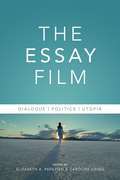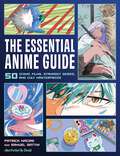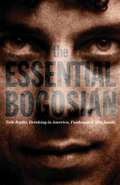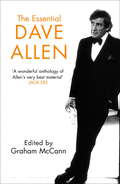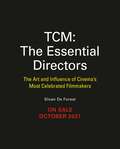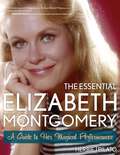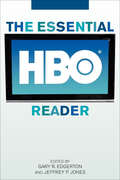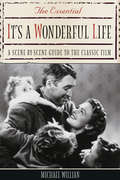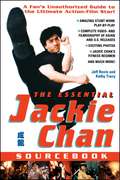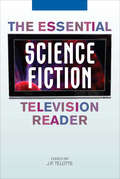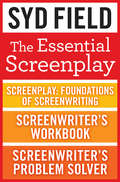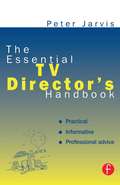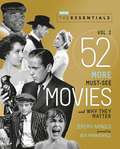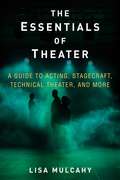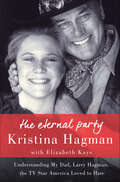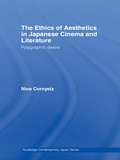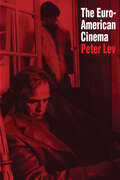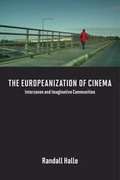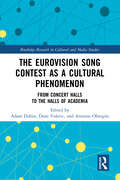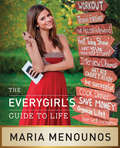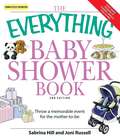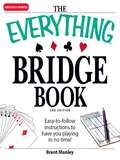- Table View
- List View
The Essay Film: Dialogue, Politics, Utopia
by Caroline Eades Elizabeth PapazianWith its increasing presence in a continuously evolving media environment, the essay film as a visual form raises new questions about the construction of the subject, its relationship to the world, and the aesthetic possibilities of cinema. In this volume, authors specializing in various national cinemas (Cuban, French, German, Israeli, Italian, Lebanese, Polish, Russian, American) and critical approaches (historical, aesthetic, postcolonial, feminist, philosophical) explore the essay film and its consequences for the theory of cinema while building on and challenging existing theories. Taking as a guiding principle the essay form's dialogic, fluid nature, the volume examines the potential of the essayistic to question, investigate, and reflect on all forms of cinema-fiction film, popular cinema, and documentary, video installation, and digital essay.A wide range of filmmakers are covered, from Dziga Vertov (Man with a Movie Camera, 1928), Chris Marker (Description of a Struggle, 1960), Nicolás Guillén Landrián (Coffea Arábiga, 1968), Pier Paolo Pasolini (Notes for an African Oresteia, 1969), Chantal Akerman (News from Home, 1976) and Jean-Luc Godard (Notre musique, 2004) to Nanni Moretti (Palombella Rossa, 1989), Mohammed Soueid (Civil War, 2002), Claire Denis (L'Intrus, 2004) and Terrence Malick (The Tree of Life, 2011), among others. The volume argues that the essayistic in film-as process, as experience, as experiment-opens the road to key issues faced by the individual in relation to the collective, but can also lead to its own subversion, as a form of dialectical thought that gravitates towards crisis.
The Essay Film: Dialogue, Politics, Utopia (Nonfictions)
by Elizabeth Caroline Eades PapazianWith its increasing presence in a continuously evolving media environment, the essay film as a visual form raises new questions about the construction of the subject, its relationship to the world, and the aesthetic possibilities of cinema. In this volume, authors specializing in various national cinemas (Cuban, French, German, Israeli, Italian, Lebanese, Polish, Russian, American) and critical approaches (historical, aesthetic, postcolonial, feminist, philosophical) explore the essay film and its consequences for the theory of cinema while building on and challenging existing theories. Taking as a guiding principle the essay form's dialogic, fluid nature, the volume examines the potential of the essayistic to question, investigate, and reflect on all forms of cinema—fiction film, popular cinema, and documentary, video installation, and digital essay.A wide range of filmmakers are covered, from Dziga Vertov (Man with a Movie Camera, 1928), Chris Marker (Description of a Struggle, 1960), Nicolás Guillén Landrián (Coffea Arábiga, 1968), Pier Paolo Pasolini (Notes for an African Oresteia, 1969), Chantal Akerman (News from Home, 1976) and Jean-Luc Godard (Notre musique, 2004) to Nanni Moretti (Palombella Rossa, 1989), Mohammed Soueid (Civil War, 2002), Claire Denis (L'Intrus, 2004) and Terrence Malick (The Tree of Life, 2011), among others. The volume argues that the essayistic in film—as process, as experience, as experiment—opens the road to key issues faced by the individual in relation to the collective, but can also lead to its own subversion, as a form of dialectical thought that gravitates towards crisis.
The Essential Anime Guide: 50 Iconic Films, Standout Series, and Cult Masterpieces
by Patrick Macias Samuel SattinFeaturing 50 of the most influential and essential Japanese animated series and films—from Akira to Cowboy Bebop to Sailor Moon—this expert guide is the must-have book for anime fans young and old. The Essential Anime Guide is the guide every fan needs to the classic, must-see anime series and films that transformed both Japanese and Western pop culture. Organized by release date and with entries by experts in the anime field, this guide provides a comprehensive, behind-the-scenes look into the history and impact of these classic anime. Both casual fans and serious otaku alike will discover a fun and surprisingly touching portrait of the true impact of anime on pop culture. Ranging from classic series to modern films, this official guide will explore iconic and must-see: Feature films: Akira (1988), Princess Mononoke (1997), Millennium Actress (2001), Metropolis (2001),Tekkonkinkreet (2006), Sword of the Stranger (2007), Summer Wars (2009), and Your Name (2016) Series: Astro Boy (1968), Lupin the 3rd (1967), Macross (1982), Ranma 1/2 (1989), Neon Genesis Evangelion (1995), Dragon Ball Z (1989), Sailor Moon (1992), Revolutionary Girl Utena (1997), Pokémon (1997), One Piece (1999), Fullmetal Alchemist (2003), K-On! (2007), Sword Art Online (2012), Yuri!! On Ice (2016), and My Hero Academia (2018) And many more!
The Essential Bogosian
by Eric Bogosian"What Lenny Bruce was to the 1950s, Bob Dylan to the 1960s, Woody Allen to the 1970s--that's what Eric Bogosian is to this frightening moment of drift in our history."--Frank Rich, The New York Times
The Essential Dave Allen
by Graham McCannWhen Dave Allen passed away in March 2005, we lost a true comedy great. Sitting cross-legged on a high stool, whiskey in one hand, cigarette in the other, Dave Allen's exasperated commentaries on the absurdities of modern life struck a chord with millions of fans in Britain, Ireland and Australia for over four decades. He was a compelling storyteller - able to spin shaggy dog stories out of the almost any subject, including the missing tip of his fourth finger of his left hand, for which he provided various unlikely explanations. But his gentle, laconic wit could also give way to ferocious attacks on the media, the state and, most famously, the Catholic Church. He was a unique talent - a comic who could make his audiences laugh, cry, and be shocked, all in one.This official celebration of Dave Allen's comedy has been drawn together by Graham McCann - Britain's best-loved entertainment writer. It is a treasure trove of stories, stand-up routines, sketches, interviews and photos, which takes us on a journey from the cradle to the grave. It will delight Dave Allen's million of fans, old and new alike.'Dave Allen was our greatest storyteller and nobody ever came close to his ability to spin a yarn. He was unique, right up there with the greats.' Jack Dee
The Essential Dave Allen
by Graham MccannWhen Dave Allen passed away in March 2005, we lost a true comedy great. Sitting cross-legged on a high stool, whiskey in one hand, cigarette in the other, Dave Allen's exasperated commentaries on the absurdities of modern life struck a chord with millions of fans in Britain, Ireland and Australia for over four decades. He was a compelling storyteller - able to spin shaggy dog stories out of the almost any subject, including the missing tip of his fourth finger of his left hand, for which he provided various unlikely explanations. But his gentle, laconic wit could also give way to ferocious attacks on the media, the state and, most famously, the Catholic Church. He was a unique talent - a comic who could make his audiences laugh, cry, and be shocked, all in one.This official celebration of Dave Allen's comedy has been drawn together by Graham McCann - Britain's best-loved entertainment writer. It is a treasure trove of stories, stand-up routines, sketches, interviews and photos, which takes us on a journey from the cradle to the grave. It will delight Dave Allen's million of fans, old and new alike.'Dave Allen was our greatest storyteller and nobody ever came close to his ability to spin a yarn. He was unique, right up there with the greats.' Jack Dee
The Essential Directors: The Art and Impact of Cinema's Most Influential Filmmakers (Turner Classic Movies)
by Sloan De ForestFrom Turner Classic Movies, this is the essential guide to all the must-know detail on the style, achievements, and landmark films of the most influential directors in cinema history from the silent era through the 1970s.For well over a century, those who create motion pictures have touched our hearts and souls; they have transported and transformed our minds, intoxicated and entranced our senses. One artist's vision is the single most prominent force behind the scenes: the director. The Essential Directors illuminates the unseen forces behind some of the most notable screen triumphs from the aesthetic peak of silent cinema through the New Hollywood of the 1970s. Considering each artist's influence on the medium, cultural impact, and degree of achievement, Turner Classic Movies presents a compendium of Hollywood's most influential filmmakers, with profiles offering history and insight on the filmmaker's narrative style, unique touches, contributions to the medium, key films, and distinctive movie moments to watch for. The work of these game-changing artists is illustrated throughout by more than 200 full-color and black-and-white photographs.In The Essential Directors you&’ll read how Cecil B. DeMille revamped religion to define an era, and how Oscar Micheaux broke barriers to become the most influential Black filmmaker of the 1920s. You&’ll marvel at the efficient artistry of &“One-Take Woody&” Van Dyke and fall in love again with the sophisticated studio-era classicsof George Cukor. You&’ll gain insight into how women like Dorothy Arzner and Ida Lupino built thriving careers in an industry ruled by men and discover what drove Mike Nichols to mix comedy with tragedy, becoming the highest-paid director of his day in the the process. The Essential Directors presents the work of these game-changing artists and dozens more in this stunning volume.
The Essential Elizabeth Montgomery: A Guide to Her Magical Performances
by Herbie J PilatoBewitched star Elizabeth Montgomery was one of the most prolific and popular actresses of the twentieth century. In her more than five hundred appearances on television, film and the stage, Elizabeth Montgomery&’s talent, charisma, and personalityhave charmed millions for decades. This delightful new book delineates, dissects, and celebrates the diversity and minutia of Montgomery&’s remarkable career, while chronicling just how much her real life spilled into her historic roles on stage and screen. The book is based on Pilato&’s exclusive interviews with the actress and supplemented withcommentary provided by myriad entertainment professionals, journalists, and media and classic TV historians, including the Oscar-nominated actress Juanita Moore (Montgomery&’s co-star from the historic &“White Lie&” episode of TV&’s 77 Sunset Strip), and producer/writer/actor Jimmy Lydon (Elizabeth&’s co-star from the Wagon Train episode &“The Victorio Bottecelli Story.&”)Including plot summaries, airdates, release dates, and behind-the-scenes notes and anecdotes of select performances, The Essential Elizabeth Montgomery is the ultimate handy, entertaining, and informative reference to the on- and off-screen adventures of one of the world&’s most beloved stars.
The Essential HBO Reader (Essential Readers in Contemporary Media and Culture)
by Gary R. Edgerton and Jeffrey P. JonesEssays on the history of HBO, a company designed to please audiences instead of advertisers, and the impact of its distinctive programming: “Recommended.” —ChoiceThe founding of Home Box Office in the early 1970s—when it debuted by telecasting a Paul Newman movie and an NHL game to 365 households in Wilkes-Barre, Pennsylvania—was a harbinger of the innovations that would transform television as an industry and a technology in the decades that followed. HBO quickly became synonymous with subscription television—and the leading force in cable programming.Over decades, it’s grown from a domestic movie channel to an international powerhouse with a presence in over seventy countries. It is now a full-service content provider with a distinctive brand of original programming, famed for such landmark shows as The Sopranos and Sex and the City. It’s brought us Six Feet Under and The Wire, Band of Brothers and Angels in America, Curb Your Enthusiasm and Def Comedy Jam, Inside the NFL and Real Sports with Bryant Gumbel, Taxicab Confessions and Autopsy, and multiple Oscar-winning documentaries.The Essential HBO Reader brings together an accomplished group of scholars to explain how HBO’s programming transformed the world of television and popular culture, and provides a comprehensive and compelling examination of HBO’s development into the prototypical entertainment corporation of the twenty-first century.“An important assessment of the original programming HBO has created in the past few decades?how these programs are derived and what impact they have had.” —Choice“A thorough treatment of HBO’s programming . . . a useful addition to a growing number of books about American television in the ‘post-network’ era.” —American Studies
The Essential It's a Wonderful Life: A Scene-By-Scene Guide to the Classic Film
by Michael WillianEven the most ardent fans of It's a Wonderful Life will be surprised and delighted by the insightful discussions of film details, cast anecdotes, curiosities, and gaffes found in this charming guide. Providing a fresh perspective, this companion includes a handy film chronology and an overview of the plot, a complete breakdown of the musical score, a fun and challenging quiz, a DVD bookmarking feature designed to give instant access to favorite scenes and other points of interest, informative historical sidebars, the complete lyrics to "Buffalo Gals," and never-before-seen maps and diagrams of downtown Bedford Falls, downtown Pottersville, the Building and Loan, and 320 Sycamore. In addition, film lovers will learn why George should have spent Christmas Eve in jail, who crashes the Bailey family Christmas Eve gathering, the story behind the sudden demise of Mr. Gower's son, how to make a flaming rum punch, the real-life site of the Bedford Falls High School "swim-gym," and other fascinating trivia related to the classic.
The Essential Jackie Chan Source Book
by RovinJackie Chan-mania swept America when Rumble in the Bronx gave movie audiences a thrilling look at the athletic actor known for performing his own jaw-dropping stunts. The Essential Jackie Chan Sourcebook reveals everything you want to know about the dare-devil dynamo who is part Buster Keaton, part Bruce Lee, and a truly unique performer in his own right -- and whose devoted cult following is exploding into international stardom. With straight talk about his rise from Hong Kong's hometown hero to Hollywood megastar, get to know the professional and persoanl Jackie Chan through His revealing biography A complete filmography -- from his early roles to the recent star vehicles Operation Condor and Thunderbolt His peak performance workout His "Catalogue of Pain" -- from concussions to broken bones -- and his many stunt work near misses His awards and accolades Up-to-the-minute internet news and fan club information And much more! Forget Stallone, Schwarzenegger and Van Damme. There's only one Jackie Chan -- and only one complete guide to the ultimate action film phenomenon!
The Essential Science Fiction Television Reader (Essential Readers in Contemporary Media and Culture)
by J.P. Telotte&“A richly detailed and critically penetrating overview . . . from the plucky adventures of Captain Video to the postmodern paradoxes of The X-Files and Lost.&” —Rob Latham, coeditor of Science Fiction Studies Exploring such hits as The Twilight Zone, Star Trek, Battlestar Galactica, and Lost, among others, The Essential Science Fiction Television Reader illuminates the history, narrative approaches, and themes of the genre. The book discusses science fiction television from its early years, when shows attempted to recreate the allure of science fiction cinema, to its current status as a sophisticated genre with a popularity all its own. J. P. Telotte has assembled a wide-ranging volume rich in theoretical scholarship yet fully accessible to science fiction fans. The book supplies readers with valuable historical context, analyses of essential science fiction series, and an understanding of the key issues in science fiction television.
The Essential Screenplay (3-Book Bundle): Screenplay, Screenwriter's Workbook, and Screenwriter's Problem Solver
by Syd FieldHollywood’s script guru teaches you how to write a screenplay in the ultimate three-volume guide to writing for film—featuring “the ‘bible’ of screenwriting” (The New York Times). This blockbuster ebook bundle includes: SCREENPLAY • THE SCREENWRITER’S WORKBOOK • THE SCREENWRITER’S PROBLEM SOLVER Syd Field was “the most sought-after screenwriting teacher in the world” according to The Hollywood Reporter. His pioneering insights into structure, concept, and character launched innumerable careers. Now in one handy collection, his invaluable expertise is available to aspiring writers and working professionals alike. The Essential Screenplay contains Syd Field’s Screenplay: The Foundations of Screenwriting, the industry standard for script development; The Screenwriter’s Workbook, a hands-on workshop full of practical exercises for creating successful screenplays; and The Screenwriter’s Problem Solver, a guide to identifying and fixing problems in your latest draft. Throughout, you’ll learn: • why the first ten pages of your script are crucially important • how to visually “grab” the reader from page one • what makes great stories work • the basics of writing dialogue • the essentials of creating great characters • how to adapt a novel, a play, or an article for the screen • the three ways to claim legal ownership of your work • tips for allowing your creative self to break free when you hit the “wall” • how to overcome writer’s block forever Featuring expert analysis of popular films including Pulp Fiction, Thelma & Louise, and the Lord of the Rings trilogy, The Essential Screenplay will transform your initial idea into a screenplay that’s destined for success—and maybe even Cannes.
The Essential TV Director's Handbook
by Peter JarvisThe Essential TV Director's Handbook is written by an ex-BBC trainer with a great deal of experience in the world of television. It describes step-by-step how to prepare and direct every familiar type of common programme format including interviews, discussions, reportage, music and dramatisations shot either on location or in the multi-camera studio. It is the essential reference handbook for any director confronted by a new programme format or the challenge of an unfamiliar technology. An appendix suggests plans for the most commonly encountered studio situations. Television culture has been changing fast. Whilst technology races on at a frightening pace programme budgets have been slashed, job descriptions widened as more people have to `multi-skill', and traditional routes of entry have become increasingly difficult to find, with diminishing access to professional training.Yet the skills and practical knowledge required to make top quality programmes remain unaltered. `The Essential .... Handbook' series offers a range of no nonsense guides to the craft of TV programme making based on tried and tested tricks of the trade. Each book is written in an entertaining and informative way providing only the essential `need to know' information for beginner broadcasting professionals and students alike.The Essential TV Director's Handbook is written by an ex-BBC trainer with a great deal of experience in the world of television. It describes step-by-step how to prepare and direct every familiar type of common programme format including interviews, discussions, reportage, music and dramatisations shot either on location or in the multi-camera studio. It is the essential reference handbook for any director confronted by a new programme format or the challenge of an unfamiliar technology. An appendix suggests plans for the most commonly encountered studio situations.Peter Jarvis is a freelance producer and director of thirty years practical experience. He is Director of Television Training International and was for eight years Senior Production Instructor with BBC's Television Training Department.
The Essentials Vol. 2: 52 More Must-See Movies and Why They Matter (Turner Classic Movies)
by Jeremy Arnold Turner Classic MoviesA guide to fifty-two examples of must-see cinema, The Essentials Vol. 2 -- based on the Turner Classic Movies series -- is packed with behind-the-scenes stories, illuminating commentary, moments to watch for, and hundreds of photos spotlighting films that define what it means to be a classic.Since 2001, Turner Classic Movies' The Essentials has been the ultimate destination for cinephiles both established and new, showcasing films that have had a lasting impact on audiences and filmmakers everywhere. In this second volume based on the series, fifty-two films are profiled with insightful notes on why they're Essential, a guide to must-see moments, and running commentary from Essentials hosts past and present: TCM's Ben Mankiewicz and the late Robert Osborne, as well as Rob Reiner, Sydney Pollack, Molly Haskell, Carrie Fisher, Rose McGowan, Alec Baldwin, Drew Barrymore, Sally Field, William Friedkin, Ava DuVernay, and Brad Bird.Enjoy one film per week for a year of stellar viewing or indulge in your own classic movie festival. Spanning the silent era through the late 1980s with such diverse films as Top Hat, Brief Encounter, Rashomon, Vertigo, and Field of Dreams, it's an indispensable book for movie lovers to expand their knowledge of cinema and discover -- or revisit -- landmark films that impacted Hollywood forever.
The Essentials of Theater: A Guide to Acting, Stagecraft, Technical Theater, and More
by Lisa MulcahyAn Introduction to the World of Theater A friendly and practical guide to the stage, The Essentials of Theater will prepare actors and crew for their next show. Perfect for college students in theater programs, as well as community theater troupes, this book covers all the bases—from a brief history on theater over the centuries and basic terminology to tips on interpreting scripts, developing characters, and utilizing props. Lisa Mulcahy’s helpful explanations and examples take readers on a backstage tour, introducing the tasks and responsibilities of every participant: stage hands, sound designers, prop managers, and more. Special sections include: A simple guide to completing your first production project Worksheets and checklists to practice new skills Interviews with theater critics, playwrights, and sound designers Appendices with suggested readings, viewings, and resources for theater students Through real-world examples and engaging activities, readers will explore every facet of the world of theater: acting, directing, playwriting, production, technical design, and more. Mulcahy even includes a chapter on innovative ways to use one’s theater education off-stage. A great resource for college theater programs and acting classes in general, The Essentials of Theater is an excellent introduction to the stage and all of its moving parts.
The Eternal Party: Understanding My Dad, Larry Hagman, the TV Star America Loved to Hate
by Elizabeth Kaye Kristina HagmanAn intimate and revealing portrait of the TV star who played J.R. on Dallas—as seen through the eyes of his daughter.When you have a very famous father, like mine, everyone thinks they know him. My dad, Larry Hagman, portrayed the ruthless oilman J.R. on the TV series Dallas. He was the man everyone loved to hate, but he had a personal reputation for being a nice guy who lived by his motto: DON’T WORRY! BE HAPPY! FEEL GOOD! Dad had a famous parent, too—Mary Martin, best known for playing Peter Pan on Broadway. Both were beloved performers, masters of crafting their public personas. But their relationship was complex and often fraught.In the hours before he died, I heard my dad beg for forgiveness, though he could not tell me what troubled him. After he died, I was compelled to learn why he felt the need to be forgiven. As I pursued the mystery of my happy-go-lucky, pot-smoking, LSD-taking dad, I came to know him—and my grandmother—better than I had known them in life.
The Ethics of Aesthetics in Japanese Cinema and Literature: Polygraphic Desire (Routledge Contemporary Japan Series #Vol. 10)
by Nina CornyetzThis is an innovative, scholarly and original study of the ethics of modern Japanese aesthetics from the 1930s, through the Second World War and into the post-war period. Nina Cornyetz embarks on new and unprecedented readings of some of the most significant literary and film texts of the Japanese canon, for instance works by Kawabata Yasunari, Mishima Yukio, Abe Kôbô and Shinoda Masahiro, all renowned for their texts' aesthetic and philosophic brilliance. Cornyetz uniquely opens up the field in a fresh and controversial way by showing how these authors and filmmakers' concepts of beauty and relation to others were, in fact, deeply impacted by political and social factors. Probing questions are asked such as: How did Japanese fascism and imperialism ideologically, politically and aesthetically impact on these literary/cinematic giants? How did the emperor as the 'nodal point' for Japanese national identity affect their ethics? What were the repercussions of the virtual collapse of the Marxist movement in the 1960s? What are the similarities and differences between pre-war, wartime and post-war ideals of beauty and those of fascist aesthetics in general? This ground-breaking work is truly interdisciplinary and will appeal to students and scholars of Japanese literature, film, gender, culture, history and even psychoanalytic theory.
The Ethnographic Optic: Jean Rouch, Chris Marker, Alain Resnais, and the Turn Inward in 1960s French Cinema (New Directions in National Cinemas)
by Laure AstourianThe Ethnographic Optic traces the surprising role of ethnography in French cinema in the 1960s and examines its place in several New Wave fictions and cinéma vérité documentaries during the final years of the French colonial empire. Focusing on prominent French filmmakers Jean Rouch, Chris Marker, and Alain Resnais, author Laure Astourian elucidates their striking pivot from centering their work on distant lands to scrutinizing their own French urban culture. As awareness of the ramifications of the shrinking empire grew within metropolitan France, these filmmakers turned inward what their similarly white, urban, bourgeois predecessors had long turned outward toward the colonies: the ethnographic gaze.Featuring some of the most canonical and best-loved films of the French tradition, such as Moi, un Noir, La jetée, and Muriel, this is an essential book for readers interested in national identity and cinema.
The Euro-American Cinema (Texas Film and Media Studies Series)
by Peter LevFrom as scholar of mass communications, an international study of the influence of Hollywood movies on twentieth-century European art films. With McDonalds in Moscow and Disneyland in Paris and Tokyo, American popular culture is spreading around the globe. Regional, national, and ethnic cultures are being powerfully affected by competition from American values and American popular forms. This literate and lively study explores the spread of American culture into international cinema as reflected by the collision and partial merger of two important styles of filmmaking: the Hollywood style of stars, genres, and action, and the European art film style of ambiguity, authorial commentary, and borrowings from other arts. Peter Lev departs from the traditional approach of national cinema histories and discusses some of the blends, overlaps, and hegemonies that are typical of the world film industry of recent years. In Part One, he gives a historical and theoretical overview of what he terms the &“Euro-American art film,&” which is characterized by prominent use of the English language, a European art film director, cast and crew from at least two countries, and a stylistic mixing of European art film and American entertainment. The second part of Lev&’s study examines in detail five examples of the Euro-American art film: Contempt (1963), Blow-Up (1966), The Canterbury Tales (1972), Paris, Texas (1983), and The Last Emperor (1987). These case studies reveal that the European art film has had a strong influence on world cinema and that many Euro-American films are truly cultural blends rather than abject takeovers by Hollywood cinema.
The Europeanization of Cinema: Interzones and Imaginative Communities
by Randall HalleIn this innovative study, German and film studies scholar Randall Halle advances the concept of "interzones"--geographical and ideational spaces of transit, interaction, transformation, and contested diversity--as a mechanism for analyzing European cinema. He focuses especially on films about borders, borderlands, and cultural zones as he traces the development of interzones from the inception of central European cinema to the avant-garde films of today. Throughout, he shows how cinema both reflects and engenders interzones that explore the important questions of Europe's social order: imperialism and nation-building in the late nineteenth and early twentieth centuries; "first contact" between former adversaries (such as East and West Germany) following World War II and the Cold War; and migration, neo-colonialism, and cultural imperialism in the twenty-first century. Ultimately, Halle argues that today's cinema both produces and reflects imaginative communities. He demonstrates how, rather than simply erasing boundaries, the European Union instead fosters a network of cultural interzones that encourage cinematic exploration of the new Europe's processes and limits of connectivity, tolerance, and cooperation.
The Eurovision Song Contest as a Cultural Phenomenon: From Concert Halls to the Halls of Academia (Routledge Research in Cultural and Media Studies)
by Antonio ObregónDrawing from the wealth of academic literature about the Eurovision Song Contest (ESC) written over the last two decades, this book consolidates and recognizes the ESC's relevance in academia by analysing its contribution to different fields of study. The book brings together leading ESC scholars from across disciplines and from across the globe to reflect on the intersection between their academic fields of study and the ESC by answering the question: what has the ESC contributed to academia? The book also draws from fields rarely associated with the ESC, such as Law, Business and Research Methodologies, to demonstrate the contest's broad utility in research, pedagogy and in practice. Given its interdisciplinary approach, this volume will be of interest to scholars and students working in cultural, media, and music studies, as well as those interested in the intersections between these areas and politics, law, education, pedagogy, and history.
The EveryGirl's Guide to Life
by Maria MenounosRaised by working-class immigrant parents and later exposed to Hollywood's most elite experts in every field, Access Hollywood's, Today's, and Nightly News's reporter Maria Menounos reveals her EveryGirl secrets on everything: her systems to organize life, manage time, and ascend the ladder of success; her lazy woman's workout; her weight-loss tips (how she lost forty pounds and kept it off); and her guide to styling yourself like the stars-a self-proclaimed EveryGirl, Maria often does her own hair and makeup for celebrity events. In The EveryGirl's Guide to Life, Maria shares personal experiences and photos from her life and professional journey as well as the various mantras, mottos, and philosophies she's adopted from the world's most impressive women. She gives advice on health, career, relationships, renovations, recreation, and more. From your carpet to the red carpet, Maria teaches the EveryGirl on a budget how to do it all, while living a healthier and happier life.
The Everything Baby Shower Book
by Sabrina Hill Joni RussellForget showers filled with boring and embarrassing games, today's baby showers are all about fun for the mommy-to-be and her guests! From invitations and games to menus and favors, The Everything Baby Shower Book, 2nd Edition helps you organize an entertaining and low-fuss party that everyone will enjoy. With dozens of party theme ideas, you'll find a party to suit any personality, including: •A piano bar sing-along for a Broadway Baby Event •A retro slumber party for the Girlfriends Go Wild Bash •Henna tattooing at the Belly Bump Revelry •Fortune-telling with tea leaves at the Tranquili-Tea Gathering •A cooking competition at the Red Wagon Food Challenge Shower •Tailgating and grilling fun at a Shower for Dads The Everything Baby Shower Book, 2nd Edition helps you throw a shower that will be the envy of every mommy-to-be!
The Everything Bridge Book (The Everything®)
by Brent ManleyWhat do Martina Navratilova, Bill Gates, and Warren Buffet have in common? They're all bridge fanatics! The card came is popular again--at home, online, and in schools. Whether readers are learning bridge from scratch or looking to improve their game, this book is the ultimate contract bridge manual. Bridge master Brent Manley takes you step by step from the rudiments of bidding to the more advanced principles of tournament play. You learn how to:Play a contract and keep scoreGain confidence in competitive biddingRecognize good vs. bad leadsSuccessfully communicate with their partnersWin tricks more frequently This book provides readers with all the skills and tips they need to play this highly social and totally addicting card game!This edition includes completely new information on:Important bridge terminologyBidding accuracy and judgmentOnline bridge
